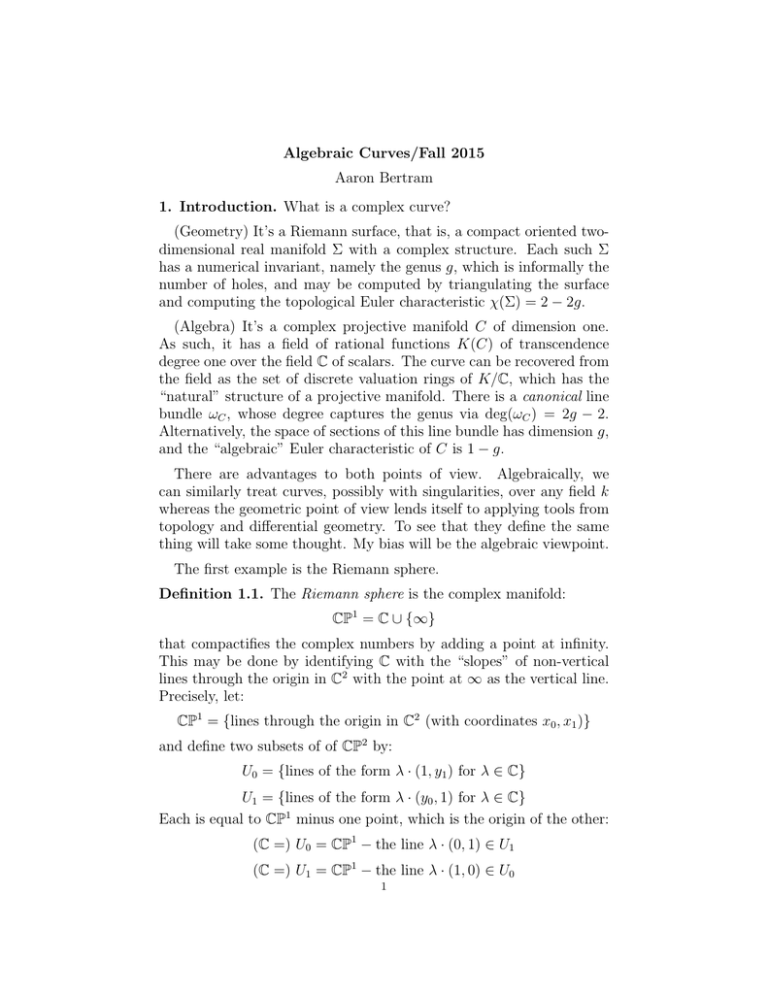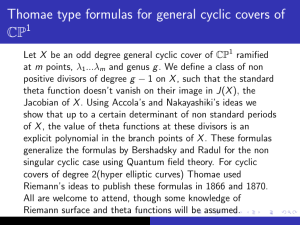Algebraic Curves/Fall 2015 Aaron Bertram 1. Introduction. What is a complex curve?
advertisement

Algebraic Curves/Fall 2015
Aaron Bertram
1. Introduction. What is a complex curve?
(Geometry) It’s a Riemann surface, that is, a compact oriented twodimensional real manifold Σ with a complex structure. Each such Σ
has a numerical invariant, namely the genus g, which is informally the
number of holes, and may be computed by triangulating the surface
and computing the topological Euler characteristic χ(Σ) = 2 − 2g.
(Algebra) It’s a complex projective manifold C of dimension one.
As such, it has a field of rational functions K(C) of transcendence
degree one over the field C of scalars. The curve can be recovered from
the field as the set of discrete valuation rings of K/C, which has the
“natural” structure of a projective manifold. There is a canonical line
bundle ωC , whose degree captures the genus via deg(ωC ) = 2g − 2.
Alternatively, the space of sections of this line bundle has dimension g,
and the “algebraic” Euler characteristic of C is 1 − g.
There are advantages to both points of view. Algebraically, we
can similarly treat curves, possibly with singularities, over any field k
whereas the geometric point of view lends itself to applying tools from
topology and differential geometry. To see that they define the same
thing will take some thought. My bias will be the algebraic viewpoint.
The first example is the Riemann sphere.
Definition 1.1. The Riemann sphere is the complex manifold:
CP1 = C ∪ {∞}
that compactifies the complex numbers by adding a point at infinity.
This may be done by identifying C with the “slopes” of non-vertical
lines through the origin in C2 with the point at ∞ as the vertical line.
Precisely, let:
CP1 = {lines through the origin in C2 (with coordinates x0 , x1 )}
and define two subsets of of CP2 by:
U0 = {lines of the form λ · (1, y1 ) for λ ∈ C}
U1 = {lines of the form λ · (y0 , 1) for λ ∈ C}
Each is equal to CP1 minus one point, which is the origin of the other:
(C =) U0 = CP1 − the line λ · (0, 1) ∈ U1
(C =) U1 = CP1 − the line λ · (1, 0) ∈ U0
1
2
and on the overlap U0 ∩ U1 , the y-coordinates are transformed via:
λ · (1, y1 ) = λ · (y1−1 , 1) and λ · (y0 , 1) = λ · (1, y0−1 )
Thus two copies of C are glued along the complements of the origin
in each by the inverse map y 7→ y −1 to obtain CP1 . But this realization
of CP1 as lines through the origin allows for the linear action of a group:
Definition 1.2. The projective linear group PGL(2, C) is the quotient:
GL(2, C)/C∗
of the group of invertible 2×2 matrices by the multiples of the identity.
The standard action of GL(2, C) results in a well-defined action:
a b
x0
ax0 + bx1
A=
=
c d
x1
cx0 + dx1
of PGL(2, C) on the lines through the origin in C2 , i.e. points of CP1 .
It is convenient to write a line in homogeneous coordinates:
(x0 : x1 ) = λ · (x0 , x1 )
and then the action above takes (x0 : x1 ) to (ax0 + bx1 : cx0 + dx1 ).
Notice that in the coordinate y0 , this action has the following form:
ay0 + b
:1
A · (y0 : 1) =
cy0 + d
and is thus only well-defined as a map from C to itself away from the
value y = −d/c. This “rational map” is known as a linear fractional
transformation of C.
This action of PGL(2, C) on CP1 is transitive. In fact:
Exercise 1.1. (a) Any three distinct points:
(p1 : q1 ), (p2 : q2 ), (p3 : q3 ) ∈ CP1
may be mapped, in order, to the points:
0 = (0 : 1), 1 = (1 : 1) and ∞ = (1 : 0), respectively ∈ CP1
by a uniquely determined element A ∈ PGL(2, C). Find this matrix,
and apply it to an arbitrary fourth point (p4 : q4 ). This is the cross
ratio of the four ordered points.
(b) What happens to the cross ratio when the points are permuted?
For an exercise with a more geometric flavor,
Exercise 1.2. What happens to the (real) lines and circles in C when
C = U1 is acted upon by a linear fractional transformation?
We may generalize the construction of the Riemann sphere to get:
3
Definition 1.2. Complex projective space CPn is similarly defined as
the set of lines through the origin in Cn+1 with coordinates x0 , ..., xn .
Analogous to the description of CP1 as C ∪ {∞}, here we have:
CPn = Cn ∪ CPn−1
which we may write in coordinates as:
CPn = {λ · (1, y1 , ..., yn )} ∪ {(0 : x1 : ... : xn )}
The former is our higher-dimensional analogue of U0 ⊂ CP1 . The full
collection of sets U0 , ..., Un ⊂ CPn and transition functions analogous
to y 7→ y −1 may be worked out, but they require a better choice of
coordinates which we will postpone until later.
Projective space is the environment in which projective varieties and,
in particular, projective algebraic curves, are found as common zero loci
of systems of homogeneous polynomial equations. We will study these
in more detail later, but notice that a polynomial F (x0 , ..., xn ) that
is a linear combination of monomials of the same degree d has the
property that F (λ · (x0 , ..., xn )) = λd · F (x0 , ..., xn ), and thus while the
value F (x0 : ... : xn ) is not well-defined, the solutions to the equation
F (x0 : ... : xn ) = 0 are well-defined as points of CPn .
Example 1.1. Consider the maps φd from CP1 to CPn given by:
φd (s : t) = (sd : sd−1 t : ... : td )
Remark 1. All such maps are well-defined.
Remark 2. Al such maps are injective (in fact, embeddings).
Remark 3. The images are cut out by quadratic equations.
The Conic. The image of φ2 is the plane conic:
{(s2 : st : t2 ) | (s : t) ∈ CP1 } ⊂ CP2
is precisely the set of solutions to the equation x0 x2 − x21 = 0.
The Twisted Cubic. The image of φ3 is the twisted cubic:
C3 = {(s3 : s2 t : st2 : t3 ) | (s : t) ∈ CP1 } ⊂ CP3
and this requires three quadratic equations to carve it out:
0 = x0 x3 − x1 x2 = x0 x2 − x21 = x1 x3 − x22
Any two of these equations will cut out C3 with an extra line. E.g.
0 = x0 x3 − x1 x2 = x0 x2 − x21
is the set of points on C3 ∪ L where L is line defined by x0 = x1 = 0.
4
The Rational Normal Curve Cd is cut out by quadratic equations
obtained by the vanishing of all the 2 × 2 minors of the matrix:
x0 x1 · · · xd−1
x1 x2 · · · xd
More generally, given homogeneous polynomials F0 , ..., Fn of the same
degree in s and t, then as long as the Fi do not simultaneously vanish
at any point (s : t) ∈ CP1 , we may use them to construct a map:
φ(s : t) = (F0 (s, t) : · · · : Fn (s : t))
whose image is always carved out by homogeneous equations. However,
these maps need not be injective!
Exercise 1.3. Find homogeneous cubic polynomials that cut out the
images of each of the following maps:
φ(s : t) = (s3 : s2 t : t3 ) and ψ(z : w) = (s3 : s2 t + st2 : t3 )
We turn next to rational functions and divisors.
Definition 1.3. The field of rational functions K(CP1 ) of CP1 is:
C(y1 ) = C(y0 )
which are two points of view of the same field. There is useful third
point of view of this field in terms of the x0 , x1 coordinate variables on
C2 . Namely, regard y0 = x0 /x1 (or y1 = x1 /x0 ) as a ratio of x variables
and “homogenize” a rational function in y0 by:
φ(y0 ) =
f (y0 )
f (x0 /x1 )
f (x0 /x1 ) · xd1
F (x0 , x1 )
=
=
=
d
g(y0 )
g(x0 /x1 )
G(x0 , x1 )
g(x0 /x1 ) · x1
where F, G are homogeneous in x0 and x1 of the same degree. E.g.
x0 /x1
y0
(x0 /x1 ) · x21
x0 x1
=
=
= 2
2
2
2
2
y0 + 1
(x0 /x1 ) + 1
((x0 /x1 ) + 1) · x1
x0 + x21
Definition 1.4. (a) A divisor on a complex curve C is:
D=
n
X
di pi
i=1
a formal sum of points pi ∈ C with integer coefficients di which is a
sum over all points of C with only finitely many nonzero coefficients.
(b) A divisor D is effective if di ≥ 0 for all i.
(c) The degree of a divisor D is the finite sum
P
i
di ∈ Z.
(d) The support of a divisor D is the finite set {pi ∈ C | di 6= 0}.
5
Any non-zero rational function on CP1 may be put in lowest terms:
Q
Q
di
(y0 − ri )di
f (y0 )
i
i (x0 − ri x1 )
Q
Q
· xe−d
φ(y0 ) =
=c·
=c·
1
e
e
j
j
g(y0 )
j (y0 − sj )
j (x0 − sj x1 )
P
P
for some c ∈ C∗ and d =
di and e =
ej .
Then the divisor of zeroes of φ on CP1 is:
X
X
div(φ) =
di · (ri : 1) −
ej · (sj : 1) + (e − d) · (1 : 0)
i
j
which is a divisor of degree zero that registers the order of zero or pole
of φ at every point of CP1 , including the point at infinity!
Looking ahead. A projective non-singular curve C will come equipped
with a field of rational functions K(C) and a “div” map that produces
a degree-zero divisor of zeroes and poles of any rational function φ
(other than the zero function).
Definition 1.5. Divisors D and D0 of the same degree on a curve C
are linearly equivalent if there exists φ ∈ K(C) such that:
div(φ) = D − D0
The Mittag-Leffler problem on an algebraic curve C is to determine
whether, for a given effective divisor D0 of degree d on C, there is a
second effective divisor D such that D ∼ D0 . More generally, we want
to know, given D0 , the full set of effective divisors D satisfying D ∼ D0 .
This is the linear series defined by D0 , which is a projective space.
On a Riemann sphere the answer is straightforward.
Proposition 1.1. Every pair of effective divisors D and D0 on CP1
of the same degree are linearly equivalent.
Proof. Write:
X
X
D=
di (ri : 1) + a · (1 : 0) and D0 =
ej · (sj : 1) + b · (1 : 0)
i
j
Then the rational function:
Q
Q
di
(y0 − ri )di
i (x0 − x1 ri )
i
Q
· xe−d
=
φ= Q
0
ej
ej
(y
−
s
)
(x
−
x
s
)
j
0
1 j
j 0
j
has the desired property.
Remark. If D ∼ D0 are a pair of linearly equivalent effective divisors
on C with disjoint supports, then φ ∈ K(C) solving div(φ) = D − D0
may be viewed as a meromorphic function on C mapping φ : C → CP1
to the Riemann sphere such that φ−1 (0 : 1) = D and φ−1 (1 : 0) = D0
(after taking multiplicities into account)
6
More generally, φ−1 (s : t) = D(s:t) are divisors (of degree d) indexed
by points of CP1 that “interpolate” between D and D0 .
Exhibiting C in this way as a branched cover of CP1 is analogous to
choosing generators and relations for a group. It determines the curve,
though (as in the case of a group) it is a highly non-trivial exercise
in general to determine whether two curves “presented” in this way as
branched covers of CP1 are isomorphic.
Notice, however, that if:
p ∼ q on a curve C
then the map
φ : C → CP1
is a bijection and, in fact, an isomorphism of algebraic curves. The
Riemann-Roch theorem will tell us that every genus zero curve has a
pair of linearly equivalent effective divisors of degree one, which implies
that every genus zero curve is isomorphic to the Riemann sphere CP1 .
The situation is completely different in higher genus, in which curves
have moduli (continuous families of non-isomorphic curves).





